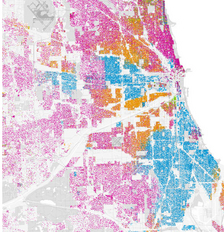| « Democracy Disappearing: Is It Time for Local School Councils to Elect Their Own School Board? | Remembering Chicago's Riotous Past » |
Chicago Mon Mar 05 2012
My Birthday Wish for Chicago: Desegregation
Chicago is huge. Geographically, very, very big for an old city. At 225 or so square miles, it could fit four Bostons inside it. New York is only 75 square miles larger, despite being almost three times as populous. Excepting Alaska, there are only three cities north of the Mason-Dixon line that are larger. I don't take seriously critiques of Chicagoans' parochialism; we live in a city of neighborhoods and Chicago's sheer scale makes comprehensive circulation throughout the city prohibitive. Besides, New Yorkers tend to stick to their boroughs.
But the city turned 175 this past week, and there is one wish I'd make as we blow out the candles: to make a serious commitment to desegregating the city.
 Chicago's desegregation is stubborn. It persists for a variety of reasons, as many invisible as visible, and not all attributable to official political policy or market pressures. But the fact is somewhat inescapable that 44 years since the passage of the Fair Housing Act, almost 50 years since the passage of the Civil Rights Act, there is an easily identifiable white Chicago, Latino Chicago, and Black Chicago.
Chicago's desegregation is stubborn. It persists for a variety of reasons, as many invisible as visible, and not all attributable to official political policy or market pressures. But the fact is somewhat inescapable that 44 years since the passage of the Fair Housing Act, almost 50 years since the passage of the Civil Rights Act, there is an easily identifiable white Chicago, Latino Chicago, and Black Chicago.
Polls show that Black Chicagoans in particular are willing and in fact desirous of living in more integrated communities. The lip service our politicians pay to diversity suggests there is at least superficial political support for diverse neighborhoods. But the segregation problem seems intractable. Why?
For one thing, it may be because in our public rhetoric segregation is not seen as a problem. This was particularly conspicuous during the ward remapping debate; the fact that it is still so easy to draw lines around massive areas of the city with homogeneous racial populations didn't seem to raise any questions about our supposedly progressive city.
My little enclave of Noble Square is somewhat integrated. There are still "white ethnic" families, and Mexican and black families despite the strong lacing of white professionals and college students that usually augurs turbo gentrification. Taking my inexhaustible puppy for a long walk around our neighborhood this weekend, one reason for this island of diversity occurred to me: at either end of the neighborhood are large low-income housing developments, with a senior public housing high rise smack in the middle. In between are two high schools and at least two elementary schools, a park, and two- and three-flats with only a smattering of single-family homes and condo blocks.
Could it be that Chicago's segregation problem is a zoning problem?
The problem of segregation is two-way. Not only are black and brown residents unable and/or unwilling to move into white neighborhoods, white residents are similarly unable, or perhaps more likely unwilling, to move into black and brown neighborhoods. If we assume that there needs to be an internal migration--that the city's extant population needs to move in order to integrate it, rather than relying on an influx from outside the city--then we can start to see the problem a little more clearly.
This is part of the uncomfortable problem of even talking about desegregation. Once we start talking about the mechanics of encouraging integration, we're talking about policies that encourage people of different races to move in predictable ways which is a little creepy.
Chicago's minority neighborhoods are, in the median, lower income than white neighborhoods. Any integrative migration can't be merely unidirectional--people moving from minority neighborhoods into white neighborhoods--because the resulting market pressure would be to significantly increase housing prices that are already by definition too high. That is, unless housing density significantly increased in white neighborhoods on the North and Northwest Sides, increasing the supply of housing, influxes of new buyers and renters would just drive up prices. But even an increase in housing supply would be problematic, since it would mean that median to above-median income families from minority neighborhoods would be leaving neighborhoods, contributing to population and wealth loss from neighborhoods that are already struggling.
So a policy of inclusionary, large-scale zoning changes would need to start in border neighborhoods that are already somewhat mixed racially, accompanied by secure amenities and integrative social services (parks and libraries, community health clinics, and legal aid clinics, and so forth). Neighborhoods like East Garfield Park, Kenwood, Washington Park, Chicago Lawn, Cragin and Ashburn are immediately obvious sites. The idea would be that as borders bleed, capillary attraction would pull people in opposite directions, eventually easing price pressure in exclusive white neighborhoods while introducing capital and services into neighborhoods that badly need them. The inherent value of exclusion in white neighborhoods would drop precipitously.
Inclusionary zoning would be comprehensive zoning changes and incentives that require not just "low-income set-asides" but density bonuses, elimination of exclusionary lot size and floor area ratio requirements, and land use planning that discourages congestion by clearing roads for buses.
Obviously, this would require a serious investment of capital--and the capital of the political kind might be even more difficult. Why should politicians bother sticking a thumb into the still tender wound of racial animus when the present set-up, allowing for the easy manipulation of voter blocs, is so beneficial? In the neoliberal city, the best answer would be an economic one; some mumbo-jumbo magical words about job creation, spontaneous order, or the like. But that can't be the first step for such a major change in focus. It's a moral question and we need, first, a moral argument. Segregation is Wrong, capital-w-wrong. It is bad in the abstract and the concrete. It undergirds political manipulation, social animus, it makes service imbalances more palatable for the powerful, severs natural communities of interest among the working classes, and robs future generations of the inherent value of diversity.
I'm heartened by the fact that social attitudes can change so quickly, as evidenced by the rapid turnaround of public attitudes towards gay marriage. The next generation are not zombified stooges fiddling on their phones; they're nimble minds uniquely--because they're all brand new--unburdened by the bigotries of past generations. If the older generation makes it a priority to articulate the moral argument, maybe the next generation of Chicagoans, celebrating the 200th birthday of their city, will be able to look back at us the way we look back at the redlining, blockbusting, white flight days today. And if I hear that comparison made on the nightly space news while drinking iced tea in my hover-recliner, I promise not to take offense.












Roland S / March 5, 2012 2:11 PM
I love the idea that we can somehow harness the forces of gentrification to create a future with more equity for all of Chicago's racial groups, where diversity is not a transitional state but a lasting one. Ultimately though, the only way to fix the problem is to make minority groups have an income distribution similar to that of whites. Anything else will require indefinite public subsidy and it will still have a basic math issue: there are far fewer upwardly-mobile blacks and Latinos than there are whites.
Until then, the best we can hope for is a largely segregated city with a handful of integrated neighborhoods.